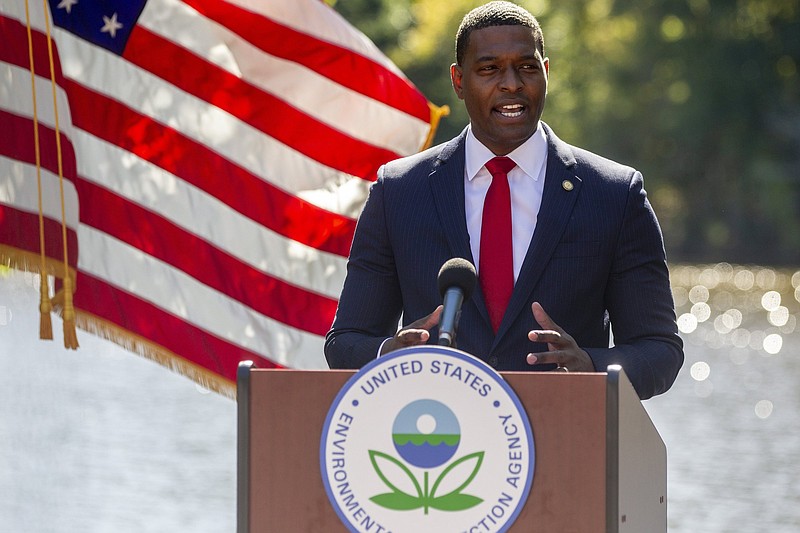WASHINGTON -- The Biden administration on Monday said it would require chemical manufacturers to test and publicly report the amount of a family of chemicals known as PFAS that is contained in household items such as tape, nonstick pans and stain-resistant furniture, the first step toward reducing their presence in drinking water.
Perfluoroalkyl and polyfluoroalkyl compounds, or PFAS, refers to more than 4,000 man-made chemicals that are often called "forever chemicals" because they do not break down in the environment. Exposure to the chemicals has been linked to certain cancers, weakened immunity, thyroid disease and other health effects.
Michael Regan, the administrator of the Environmental Protection Agency, said in an interview that regulating PFAS has been one of his priorities. He previously served as the top environmental regulator in North Carolina where startlingly high concentrations of the chemicals were found in several sources of public drinking water.
"PFAS contamination has been devastating communities for decades. I saw this firsthand in North Carolina," Regan said. He recounted visiting with mothers unsure if their children's drinking water was safe, and caregivers wondering if a loved one's terminal illness was associated with exposure to the chemicals.
The new EPA testing requirements will go into effect "in a matter of weeks," Regan said. The agency did not provide an estimate of the cost to manufacturers, but Regan said it is a cost that industry, not taxpayers, should bear.
"It could be expensive, but it's necessary," Regan said. "It's time for manufacturers to be transparent and provide the American people with this level of detail," he said.
Thousands of chemicals classified as PFAS are ubiquitous in consumer products because they increase resistance to heat, stains, water and grease. The EPA plans to group the chemicals into 20 subcategories based on shared characteristics. By the end of 2021, the EPA will require manufacturers to test chemicals from each grouping, which the agency said will yield data on more than 2,000 PFAS to inform EPA plans going forward.
The EPA announced additional regulatory steps it intends to formally propose by 2022 that involve PFAS, Regan said.
The list, which the EPA described as a "road map," includes setting legal limits for safe levels of PFAS in drinking water, which the chemical industry tentatively supports; designating it as a hazardous substance under the laws that govern toxic Superfund sites, which industry opposes policies; and increasing monitoring and research.
Meanwhile, the Department of Defense is expected to review how to clean PFAS contamination at nearly 700 military installations and National Guard locations by the end of 2023. The chemicals are in a foam used at military installations and by civilian firefighters to extinguish fires.
The EPA has set a lifetime health advisory for two types of PFAS in drinking water at 70 parts per trillion -- essentially cautioning that sustained exposure above that level could cause adverse effects. Agency officials said it is too soon to say whether the EPA will recommend that threshold or a different one when it develops formal drinking water limits.
The American Chemistry Council, a trade organization, noted that about 600 chemicals in the PFAS category are used to manufacture products such as solar panels and cellphones and said alternative materials might not be available to replace them. "The American Chemistry Council supports the strong, science-based regulation of chemicals, including PFAS substances. But all PFAS are not the same, and they should not all be regulated the same way," Erich Shea, a spokesperson for the organization, said in a statement.
Environmentalists said they do not believe there is a safe level of PFAS in drinking water.
Kemp Burdette, 47, works for Cape Fear River Watch in Wilmington, North Carolina, where he used to encourage people to drink tap water to avoid using disposable plastic bottles. Then he discovered that PFAS levels in the local tap water had reached as high as 6,000 parts per trillion, the result of years of contaminated wastewater discharged into the Cape Fear River by a Dupont plant, later owned by The Chemours Co.
"All of a sudden you're like, 'What's in the water? What is this stuff? How long have we been drinking it'?" Burdette said. "My kids were drinking that water all their lives."
The North Carolina Department of Environmental Quality, then under the leadership Regan, ultimately reached an agreement requiring Chemours to pay a $13 million fine.
A spokesperson for Chemours referred questions to the American Chemistry Council.
